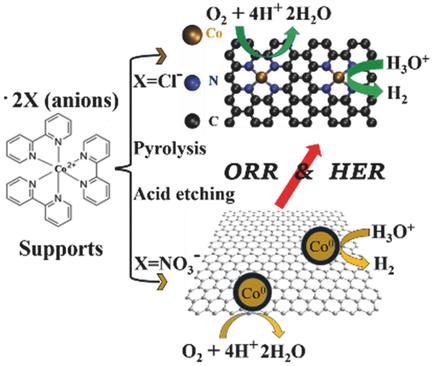当前位置:
X-MOL 学术
›
Adv. Mater.
›
论文详情
Our official English website, www.x-mol.net, welcomes your
feedback! (Note: you will need to create a separate account there.)
Anion‐Regulated Selective Generation of Cobalt Sites in Carbon: Toward Superior Bifunctional Electrocatalysis
Advanced Materials ( IF 27.4 ) Pub Date : 2017-11-06 , DOI: 10.1002/adma.201703436 Gang Wan 1, 2 , Ce Yang 3 , Wanpeng Zhao 1, 2 , Qianru Li 1, 2 , Ning Wang 1, 2 , Tao Li 4 , Hua Zhou 4 , Hangrong Chen 1 , Jianlin Shi 1
Advanced Materials ( IF 27.4 ) Pub Date : 2017-11-06 , DOI: 10.1002/adma.201703436 Gang Wan 1, 2 , Ce Yang 3 , Wanpeng Zhao 1, 2 , Qianru Li 1, 2 , Ning Wang 1, 2 , Tao Li 4 , Hua Zhou 4 , Hangrong Chen 1 , Jianlin Shi 1
Affiliation

|
The introduction of active transition metal sites (TMSs) in carbon enables the synthesis of noble‐metal‐free electrocatalysts for clean energy conversion applications; however, there are often multiple existing forms of TMSs, which are of different natures and catalytic models. Regulating the evolution of distinctive TMSs is highly desirable but remains challenging to date. Anions, as essential elements involved in the synthesis, have been totally neglected previously in the construction of TMSs. Herein, the effects of anions on the creation of different types of TMSs are investigated for the first time. It is found that the active cobalt–nitrogen sites tend to be selectively constructed on the surface of N‐doped carbon by using chloride, while metallic cobalt nanoparticles encased in protective graphite layers are the dominant forms of cobalt species with nitrate ions. The obtained catalysts demonstrate cobalt‐sites‐dependent activity for oxygen reduction reaction and hydrogen evolution reaction in acidic media. The remarkably enhanced catalytic activities approaching that of benchmark Pt/C in an acidic medium have been obtained on the catalyst dominated with cobalt–nitrogen sites, confirmed by the advanced spectroscopic characterization. This finding demonstrates a general paradigm of anion‐regulated evolution of distinctive TMSs, providing a new pathway for enhancing performances of various targeted reactions related with TMSs.
中文翻译:

阴离子调控碳中钴位点的选择性生成:迈向卓越的双功能电催化
在碳中引入活性过渡金属位点(TMS)可以合成用于清洁能源转换应用的无贵金属电催化剂;但是,通常存在多种形式的TMS,它们具有不同的性质和催化模型。监管独特的TMS的发展是非常可取的,但迄今为止仍然具有挑战性。阴离子,作为合成中必不可少的元素,以前在TMS的构建中已被完全忽略。本文中,首次研究了阴离子对创建不同类型TMS的影响。研究发现,通过使用氯化物,活性钴-氮位点倾向于选择性地构造在氮掺杂碳的表面上,包裹在保护性石墨层中的金属钴纳米颗粒是带有硝酸根离子的钴物种的主要形式。所获得的催化剂证明了钴在酸性介质中对氧还原反应和氢释放反应的依赖性。先进的光谱表征证实,在钴-氮位点占主导的催化剂上,已获得了在酸性介质中接近基准Pt / C的显着增强的催化活性。这一发现证明了阴离子调控独特TMS进化的一般范式,为增强与TMS相关的各种靶向反应的性能提供了一条新途径。所获得的催化剂证明了钴在酸性介质中对氧还原反应和氢释放反应的依赖性。先进的光谱表征证实,在钴-氮位点占主导的催化剂上,已获得了在酸性介质中接近基准Pt / C的显着增强的催化活性。这一发现证明了阴离子调控独特TMS进化的一般范式,为增强与TMS相关的各种靶向反应的性能提供了一条新途径。所获得的催化剂在酸性介质中表现出钴位依赖性的氧还原反应和氢释放反应活性。先进的光谱表征证实,在钴-氮位点占主导的催化剂上,已获得了在酸性介质中接近基准Pt / C的显着增强的催化活性。这一发现证明了阴离子调控独特TMS进化的一般范式,为增强与TMS相关的各种靶向反应的性能提供了一条新途径。
更新日期:2017-11-06
中文翻译:

阴离子调控碳中钴位点的选择性生成:迈向卓越的双功能电催化
在碳中引入活性过渡金属位点(TMS)可以合成用于清洁能源转换应用的无贵金属电催化剂;但是,通常存在多种形式的TMS,它们具有不同的性质和催化模型。监管独特的TMS的发展是非常可取的,但迄今为止仍然具有挑战性。阴离子,作为合成中必不可少的元素,以前在TMS的构建中已被完全忽略。本文中,首次研究了阴离子对创建不同类型TMS的影响。研究发现,通过使用氯化物,活性钴-氮位点倾向于选择性地构造在氮掺杂碳的表面上,包裹在保护性石墨层中的金属钴纳米颗粒是带有硝酸根离子的钴物种的主要形式。所获得的催化剂证明了钴在酸性介质中对氧还原反应和氢释放反应的依赖性。先进的光谱表征证实,在钴-氮位点占主导的催化剂上,已获得了在酸性介质中接近基准Pt / C的显着增强的催化活性。这一发现证明了阴离子调控独特TMS进化的一般范式,为增强与TMS相关的各种靶向反应的性能提供了一条新途径。所获得的催化剂证明了钴在酸性介质中对氧还原反应和氢释放反应的依赖性。先进的光谱表征证实,在钴-氮位点占主导的催化剂上,已获得了在酸性介质中接近基准Pt / C的显着增强的催化活性。这一发现证明了阴离子调控独特TMS进化的一般范式,为增强与TMS相关的各种靶向反应的性能提供了一条新途径。所获得的催化剂在酸性介质中表现出钴位依赖性的氧还原反应和氢释放反应活性。先进的光谱表征证实,在钴-氮位点占主导的催化剂上,已获得了在酸性介质中接近基准Pt / C的显着增强的催化活性。这一发现证明了阴离子调控独特TMS进化的一般范式,为增强与TMS相关的各种靶向反应的性能提供了一条新途径。











































 京公网安备 11010802027423号
京公网安备 11010802027423号